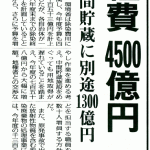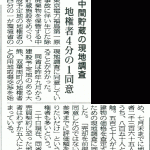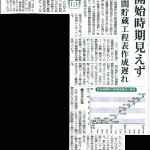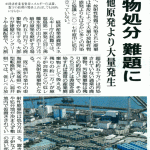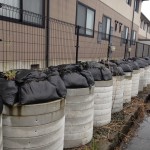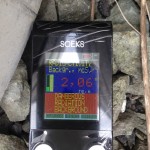Original Japanese written by staffer
The English below translated from the original Japanese by Heeday
The English translation edited by Rev. Dr. Henry French, ELCA
(Sources: articles of August 21st and 23rd, 2015 editions of the Fukushima Minpo newspaper)
Click each image to enlarge it and read the caption.
Today, we are witnessing the emergence of many new and complex issues with the processing of the radioactive waste collected during the “decontamination” work following TEPCO’s Fukushima Daiichi Nuclear Power Plant’s meltdown.
Since the relevant municipalities plan to complete the “decontamination” work by the end of FY2016, Japan’s Ministry of the Environment is demanding an expanded budget of some 450 billion yen for FY2016, an increase from this year’s 415.3 billion yen. Acquisition of land for intermediate storage of such waste is lagging behind schedule. Therefore, the Ministry intends to expand the budget for land acquisition considerably, from this year’s 75.8 billion yen to 130 billion yen next fiscal year, and they are assigning more officials than today to take care of negotiations with landowners.
Since the existing temporary storage sites for radioactive waste are already full, much of the collected waste has no place to go. Some of it is simply buried under gardens, some is kept under house eaves or somewhere else within the premises. Known as “collection site storages,” more than 100,000 of such “storages” currently exist in Fukushima Prefecture.
Things are no different here in Koriyama City, where our Project’s office is. The decontamination work is progressing very slowly. When a citizen, at long last, welcomes in decontamination workers, the radioactive soil they collect is either buried in the citizen’s own yard or kept somewhere else within the premises – possibly under the eaves. He/she simply cannot have any peace of mind.
A decontamination subcontractor does the collection work, and then digs a large, deep hole in the yard and buries the collected radioactive soil which has been wrapped up in big vinyl sheets. An unsuspecting child often plays in the same yard, above the underground radioactive soil, while his/her parents anxiously watch.
We can see heaps of vinyl-packed radioactive soil here and there as we walk around. We measured the radioactivity at one such heap under the eaves of an apartment house in the neighborhood of our Project’s office. The counter showed 2mSv/h. The dose can exceed that amount following a rainfall or on a windy day. We find weeds, growing out of the contaminated soil and sticking out of the vinyl bags. No one thinks such bags containing radioactive soil are strong enough to withstand aging for years to come.
Click each image to enlarge it and read the caption.
Furthermore, the Fukushima Daiichi Nuclear Power Plant is to be decommissioned, and more radioactive waste will result from the decommissioning of the plant. No one knows what to do with this new waste, at least at this moment. Although the Japanese Government has said concerning radioactive waste, “It should be buried within the nuclear plant’s premises, as is done in many other countries,” in reality, Fukushima Daiichi’s premises are already occupied with numerous tanks containing radioactive water. Those tanks are growing larger and larger in number every day. The plant’s premises have no space to accommodate more waste. Also, the tanks themselves will become radioactive waste someday. In a regular decommissioning, it is hard to win consent of the neighboring municipalities. In the case of Fukushima Daiichi, this consent should be even harder to win, since Fukushima’s citizens are victims of the meltdown.
I (the author) have a feeling that all of this ever-expanding radioactive waste will eventually be “pushed” off onto Fukushima’s citizens. If we go on seeking for wealth and ignoring the negative results that come from such wealth, in the long run, what kind of a world are we going to build?
Here in Koriyama City, we see the piles of collected radioactive soil growing larger and larger every day. Many children, with their futures before them, walk beside these heaps of contaminated soil. And that has become part of the ordinary cityscape here.

